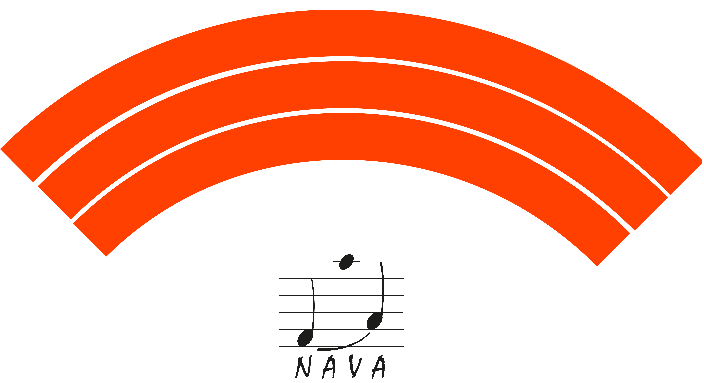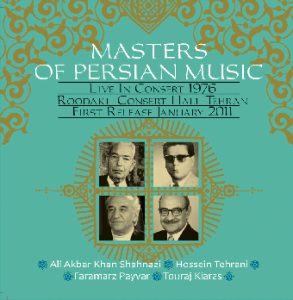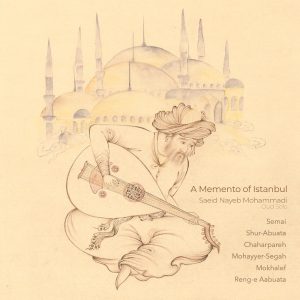
Centre of Excellence for the promotion Classical and Regional Music of Iran

Masters of Persian Music
Published by: Nava Arts UK
Year of Publication: 2011
The day after I filed last week’s review of Shahkilid’s new disc, Nedaye Asemani, this CD came through the letterbox. And what it does is flesh out the tradition to which I alluded, while praising the work of a contemporary Iranian group of improvisers who had managed to remain true in spirit to their country’s ancient style. This recording – which has never been released before – is of a live concert in Teheran in 1976, just three years before the revolution.
The ultra-refined style developed by oud player Barbad in the 6th century was the preserve of the courts until the early 20th century, when it became staple fare for intimate gatherings; the 1979 revolutionaries first boosted it as a replacement for Western pop, then proscribed it, before encouraging its growth once more.
But only in small, often private venues, and within limits: women may not sing for an audience of men, and every lyric (sung by anybody) must be vetted for religious correctness.
Ali Akbar Shahnazi, the player here on the tar lute, was born in the 19th century, while his colleagues were born at the start of the 20th: with voice, drum, and zither they deliver their exquisitely codified “radif” with burning conviction.
Review by: Michael Church
Publication: The Scotsman
Date of Review: February 2011
Available from: Nava Arts UK (please email)

A Memento Of Istanbul
Published by: Nava Arts UK
Year of Publication: 2023
To which region does Oud, this mythical instrument, belong? North Africa, Andalusia, the Arab Mashriq, Iran, Turkey? This geographical realm has led to the perception of Oud always and fundamentally within a ‘multicultural’ context, making it challenging to exclusively attribute this instrument to one particular musical tradition, especially when it comes to a distinguished Oud performance which does not include any lyrics. Nevertheless, it goes without saying that the musical elements and aesthetic characteristics of each culture display various nuances and facets of Oud.
A Memento of Istanbul is a journey of an “Iranian” Oud where it can loudly and passionately express itself, free and unrestrained, even in the public sphere – going over its achievements and merits. The musical behaviours of this Oud remind the listener of its Iranian essence throughout the auditory experience: modal sequences influenced by the modal system of classical Iranian music (dastgâh); melodic hints that seem to represent the lyricism of Persian poetry and literature in Iranian music; explicit presence of certain Iranian melodic types (gusheh), and occasionally, but not so explicitly, the appearances of Iranian melodic materials from the past century (perhaps resulting from the aesthetic archive in the performer’s mind); and ultimately, the influences that this Oud playing, consciously or subconsciously – but logically and inevitably – has accepted from the performance styles of other Iranian instruments (such as Târ in some metric pieces or even the Khorasani Dutar in certain moments of Track 4).
Furthermore, among the Iranian vivid imprints on this canvas, the given musical tableau is filled with details that the performer has adopted from the multicultural world of Oud, e.g., disconnected tremolos in many cases, a broad dynamic range, wide vibratos, and perhaps the most distinct characteristic – ‘timing’ that mostly evokes the Arab style of Oud performance.
Yet all these detailed analyses make sense only once we stop the “time” and attempt to rationally “think” about music outside the realm of enchantment. This is while right after the first notes of the album, we seem to inhale a dense smoke of an enchanting musical narcotic: time loses its meaning, and we embark on an illusory journey in the Eastern world of these sounds… and with the final note, we find ourselves once again on the solid ground.
Review by: Saeid Yaqubian
Publication: Nava Arts
Date of Review: June 2023
A Memento Of Istanbul
Published by: Nava Arts UK
Year of Publication: 2023
To which region does Oud, this mythical instrument, belong? North Africa, Andalusia, the Arab Mashriq, Iran, Turkey? This geographical realm has led to the perception of Oud always and fundamentally within a ‘multicultural’ context, making it challenging to exclusively attribute this instrument to one particular musical tradition, especially when it comes to a distinguished Oud performance which does not include any lyrics. Nevertheless, it goes without saying that the musical elements and aesthetic characteristics of each culture display various nuances and facets of Oud.
A Memento of Istanbul is a journey of an “Iranian” Oud where it can loudly and passionately express itself, free and unrestrained, even in the public sphere – going over its achievements and merits. The musical behaviours of this Oud remind the listener of its Iranian essence throughout the auditory experience: modal sequences influenced by the modal system of classical Iranian music (dastgâh); melodic hints that seem to represent the lyricism of Persian poetry and literature in Iranian music; explicit presence of certain Iranian melodic types (gusheh), and occasionally, but not so explicitly, the appearances of Iranian melodic materials from the past century (perhaps resulting from the aesthetic archive in the performer’s mind); and ultimately, the influences that this Oud playing, consciously or subconsciously – but logically and inevitably – has accepted from the performance styles of other Iranian instruments (such as Târ in some metric pieces or even the Khorasani Dutar in certain moments of Track 4).
Furthermore, among the Iranian vivid imprints on this canvas, the given musical tableau is filled with details that the performer has adopted from the multicultural world of Oud, e.g., disconnected tremolos in many cases, a broad dynamic range, wide vibratos, and perhaps the most distinct characteristic – ‘timing’ that mostly evokes the Arab style of Oud performance.
Yet all these detailed analyses make sense only once we stop the “time” and attempt to rationally “think” about music outside the realm of enchantment. This is while right after the first notes of the album, we seem to inhale a dense smoke of an enchanting musical narcotic: time loses its meaning, and we embark on an illusory journey in the Eastern world of these sounds… and with the final note, we find ourselves once again on the solid ground.
Review by: Saeid Yaqubian
Publication: Nava Arts
Date of Review: June 2023
A Memento Of Istanbul
Published by: Nava Arts UK
Date of Publication: 2023
Saeid Nayeb Mohammadi is an independent Iranian musician who has always been at the forefront of revival movements in his country’s musical culture. The first revival movement to which his musical activities are deeply connected is the revival of an ancient instrument, the oud, the origin of which is said to be in Iran. This instrument was absent from the music scene of the country for several centuries, but thanks to the efforts of some musicians in recent decades (including Nayeb Mohammadi), it has made a comeback. Saeid Nayeb Mohammadi is an oud player and, without exaggeration, one of the prominent representatives of playing this instrument in Iran. He has managed to harmonise the language of this instrument with the characteristics of contemporary Iranian classical music. His albums, such as “Nazm-o-Nasr (Poetry and Prose)” and “Qowl-o-Ghalza”l not only showcase his improvisatory skills and ability to create cohesive and captivating compositions but also attest to his strength in creating the harmony pointed to above.
The other revival movements he has been involved in are contemporaneous to him and he has actively participated in promoting them. One of these movements is the revival of an old compositional style based on principles discussed in the Timurid treatises (over the 15th and 16th centuries), while the other is the revival of interest in music from the neighbouring traditions. This is to create a linkage to the aesthetics and musical techniques of these neighbouring musical cultures, aiming to retrieve what was once a relatively unified cultural body. Generally referred to as Iranian-Arabic-Turkish music, this family of musical traditions share a lot in terms of their aesthetic traits. Nayeb Mohammadi is situated within both movements; whether through his compositions in the album “Sarkhaneh” as well as his subsequent independent work, “Modulating Tunes”, which are particularly the manifestations of the first movement (a style one may nowadays refer to as “neoclassical”), or by means of his last two albums that deliberately feature discernible traces of Arabic music.
Another album of his, “Rey to Rume” – a music journey from the city of Tehran (Rey) to the Ottoman-dominated Rum – symbolically represents the composer’s attention to the roots and his interest in reviving the connection between musical cultures that have been detached from each other. Undoubtedly, his instrument, the oud, and his training with some Arab masters, such as Salem Abdul Kareem, played a role in developing this interest and sense of kinship and inclination towards reconnection. Yet, aside from the fact that the Iranian language of his oud playing has remain independent from the influence of these tendencies and interests, his sympathy for and engagement with the aforementioned revival movements has been far beyond being passive, but rather fully conscious.
Nayeb Mohammadi’s success in these areas is not dependent on intellectual support and theoretical-historical discourses, or even what can be called “the attractions of trends in art”. Rather, it is entirely due to his artistic abilities and creative mind, which are evident in the creation and development of melodic and rhythmic ideas, modal colourings, and formal architecture of his works, including his recent album, “A Memento of Istanbul”.
In this new album, unlike many young musicians of his generation who dismiss the model repertoire of classical Iranian music (radif) in a radical way, he creates an instrumental suite for solo oud, which begins with a metric introduction, resonating with the way in which a suite is organised in modern tradition of classical Iranian music. Yet, conforming to the old tradition and following the neoclassical movement, this introduction adheres to the compositional form of pishrow. What follows is a long improvisation (over 25 minutes) which starts with a melody derived from the pishrow refrain (molazemeh or taslim), while comprising at various moments, melodic motifs from the repertoire of radif. The entire improvisation unfolds with dramatic intensities and fluctuations arising from the tension-release interplay. These are sometimes inherent in the modes chosen, and at times intrinsic features of the given melodic and rhythmic patterns. This musical journey, inspired by the memories of the composer’s long stay in Istanbul, does not suffer at any moments of its progression from the drastic drops of energy, often found in the works of many contemporary young musicians, who always begin their works with good ideas and highly energetically but lose momentum halfway through. As far as this new album is concerned, throughout this seamless and cohesive suite, the listener’s attention remains focused on the music, both in moments of dramatic tension and those of serene calm, which last as much as needed, leaning to moments of introspection and depth. The work is filled with melodic variations, ranging from breath-taking phrasings that postpone the cadential resolutions to creatively expanding of the melodies derived from radif, at times merging with timely and harmonious colorings. As case in point is the repetition of a melody in the lower range at the end of the piece: a rare and exceptional example of a brilliant bass in Iranian music on a traditional instrument. Following a joyous melody devoid of dramatic contrasts, the modulation towards the end of the piece reaches moments of contemplation, eventually returning to the main mode. This leads to the end of the suite: contrary to the conventional expectation that such suites would conclude with a carefree dancing piece that liberate the listener’s mind, the whole suite of “A Memento of Istanbul “gracefully and lightly comes to an end with, which result from the simplicity and accessibility of the melody with its descending sequences.
Review by: Prof. Sasan Fatemi
Publication: blog flook magazine
Date of Review: September 2023


